10.8
Compressed Air Systems (§120.6(e))
10.8.1
Overview
§120.6(e)
applies to all new compressed air systems with a total installed compressor
capacity of ≥25 hp. It also applies to existing compressed air systems
that are being altered on the supply side (equipment upstream of the
distribution system). For alternations there is an exception for systems
that include one or more centrifugal compressors.
As described in the following paragraphs, there are 3 main
requirements in this section:
•
Trim
Compressor and Storage (§120.6(e)1)
•
Controls (§120.6(e)2), and
•
Acceptance (§120.6(e)3)
10.8.2
Mandatory Measures §120.6(e)
A.
Trim
Compressor and Storage (§120.6(e)1)
This requirement targets the performance of a compressed
air system across its full range. This requirement excludes
alterations that are not making a large change to the system. A large
change is defined as adding or replacing more than 50% of the online
capacity.
There are two alternate paths to comply with this
requirement:
•
Using a VSD controlled compressor(s) as the Trim Compressor (§120.6(e)1A)
•
Using a compressor or set of compressors as the Trim Compressor
(§120.6(e)1B)
Both of these paths aim to reduce the amount of cycling of
fixed speed compressors by utilizing a better-suited compressor that operates
well in part-load.
Compliance Option 1: VSD-controlled Trim Compressor
(§120.6(e)1A)
In order to avoid control gaps - portions of the compressed
air system range with poor performance - it’s important to have a trim
compressor sized to handle the gaps between base compressors. This minimum
size is determined with the Largest Net
Capacity Increment - the biggest step increase between combinations
of base compressors.
With equally sized compressors this is fairly intuitive: in a
system with two-100 hp (434 acfm) rotary screw compressor system, the largest
step increase would be the size of one of the compressors (434 acfm). For
systems with uneven compressor sizes, it requires going through the following
steps:
a) Determine all combinations of base
compressors (including all compressors off).
b) Order these combinations in increasing
capacity.
c) Calculate the difference between every
adjacent combination.
d) Choose the largest difference.
This largest difference is what must be covered by the trim
compressor(s) in order to avoid a control gap.
Example
10-55
Question
Given
a system with three base compressors with capacities of 200 acfm (Compressor A),
400 acfm (Compressor B) and 1,000 acfm (Compressor C), what is the Largest
Net Capacity Increment?
Answer
As
shown in the image below there are 8 possible stages of capacity ranging from 0
acfm with no compressors to 1,600 acfm with all three compressors
operating. The largest net increment is between stage 4 with compressors A
and B operating (200+400=600acfm) to stage 5 with compressor C operating (1,000
acfm)
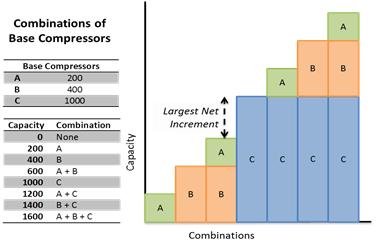
For
this system the Largest Net Capacity Increment is 1,000 acfm-600 acfm =
400 acfm
Once the Largest Net Capacity Increment is calculated,
this value can be used to satisfy the first compliance option. Option one
mandates that the rated capacity of the VSD compressor(s) be at least 1.25 times
the largest net increment.
Example
10-56
Question
Using
the system from the previous example, what is the minimum rated capacity of VSD
compressor(s) that are needed to comply with Option 1?
Answer
As
previously shown, the Largest Net Capacity Increment is 1,000 acfm-600
acfm = 400 acfm. The minimum rated capacity for VSD compressor(s) is 400
acfm X 1.25 = 500 acfm.
For compliance option 1, the system must include primary
storage that has a minimum capacity of 1 gallon for every acfm of capacity
of the largest trim compressor.
Example
10-57
Question
What
is the required minimum primary storage capacity for the trim compressor from
the previous example to comply with Option 1?
Answer
Assuming
there is a VSD compressor with a rated capacity of 500 acfm, per §120.6(e)1A
it must have 1 gallon of storage per acfm of rated capacity or 500*1 = 500
gallons of storage.
Compliance Option 2: Other Compressors as Trim Compressor
(§120.6(e)1B).
The second compliance option offers more flexibility but
requires looking at both the Largest Net Capacity Increment of the
system, as well as the Effective Trim Capacity of the trim
compressor(s).
The Effective Trim Capacity is the range across which
a trim compressor has adequate part-load performance. Performance is
measured in power input over air volume output or specific power
(kw/100acfm). Many VSD compressors come with a compressor performance
graph in a CAGI data sheet that looks similar to the graph in Figure
10-40.Figure 10-40–Example Compressor Power vs. Capacity Curve
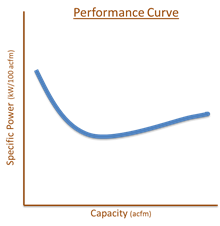
The capacity of the compressor is along the x-axis, while the
power is on the y-axis. The curve in Figure 10-41 is a typical shape
of a performance curve for a VSD compressor. The lower the specific power,
the more energy efficient the compressor is at that condition.
The Effective Trim Capacity uses the minimum of the
compressor power vs. capacity curve to determine the range of adequate part-load
performance. This can be done in the following steps and is illustrated in
the graph below.
a) Find the minimum specific power across the
range.
b) Find the upper bound by calculating 1.15
times the minimum specific power.
c) Determine the endpoints of the capacity
where the specific power is less than or equal to the upper bound.
d) The difference between these two endpoints
is the effective trim capacity.
Figure 10-41 –Determination of Effective Trim
Capacity from a Compressor Curve
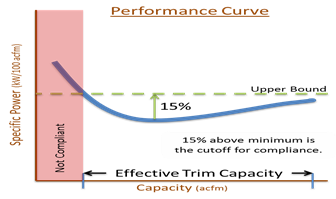
This definition of Effective Trim Capacity, along with
the Largest Net Capacity Increment of the system, will be used
to assist in sizing the trim compressor appropriately in the next section.
Example
10-58
Question
Continuing
with the system from the previous examples, what is the required minimum
Effective Trim Capacity of the trim compressor(s) to comply with Option
2?
Answer
As
previously shown, the Largest Net Capacity Increment is 1,000 acfm-600
acfm = 400 acfm. Per §120.6(e)1
the minimum Effective Trim Capacity is equal to the Largest Net
Capacity Increment or 400 acfm.
Example
10-59
Question
A
manufacturer provided the following data for their compressor; would this
provide the minimum Effective Trim Capacity for this system to comply
with Option 2?
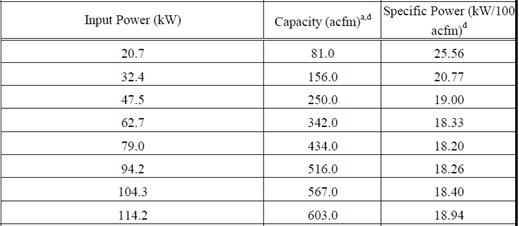
Answer
From
the manufacturer’s data the minimum specific power is 18.2 kW/100 acfm.
The upper limit would be 18.2 * 1.15 = 20.9 kW/100 acfm. Interpolating
from the manufacturer’s data this appears to go from 155 acfm to 605 acfm for an
Effective Trim Capacity of 605-155= 450 acfm. This is larger than the
Largest Net Capacity Increment of 400 acfm so this compressor
would comply as a trim compressor for this system.

For compliance option 2, the system must include primary
storage that has a minimum capacity of 2 gallons for every acfm of capacity
of the largest trim compressor.
Example
10-60
Question
What
is the required minimum primary storage capacity for the trim compressor from
the previous example to comply with Option 2?
Answer
This
compressor has a rated capacity of 603 acfm, per §120.6(e)1B
it must have 2 gallons of storage per acfm of rated capacity or 603*2 = 1,206
gallons of storage.
The last example used a VSD compressor, but other
technologies can be used for compliance option 2. The next example
examines a 250-hp load-unload, single stage, rotary screw compressor coupled
with 10 gallons/cfm of storage. Generally, higher levels of storage
improve part-load performance and this combination was chosen to meet the
part-load performance mandated by code. This data was generated from
theoretical curves used in AirMaster+, a tool created by the U.S. Department of
Energy.
Example
10-61
Question
Part-load
data was approximated below for a 250-hp load-unload, single stage, rotary screw
compressor coupled with 10 gallons/cfm of storage; would this provide the
minimum Effective Trim Capacity for this system to comply with Option
2?
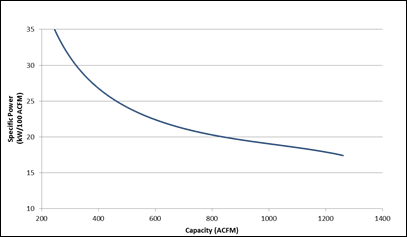
Answer
Using
the previous examples, a compressor with an effective trim capacity of at least
400 acfm is necessary.
Looking
at the graph, the minimum specific power (labeled as A below) occurs at full
load - a capacity of 1261 acfm, with a specific power of 17.4 kW/100acfm.
Using this minimum specific power, the upper bound is 17.4 * 1.15 = 20.01
kW/100acfm or 15% higher than the minimum specific power. This puts the
ends of the effective trim capacity at 1261 acfm (labeled as B) and 845 acfm
(labeled as C), resulting in an effective trim capacity of 1261 – 845 = 416
acfm. This is larger than the Largest Net Capacity Increment of 400 acfm
so this compressor would comply as a trim compressor for this
system.
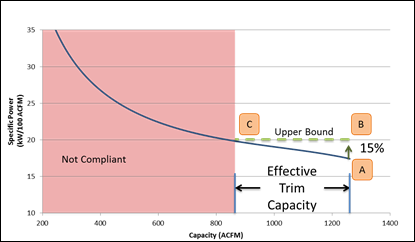
For compliance option 2, the system must include primary
storage that has a minimum capacity of 2 gallons for every acfm of capacity of
the largest trim compressor.
Example
10-62
Question
What
is the required minimum primary storage capacity for the trim compressor from
the previous example to comply with Option 2?
Answer
This
compressor has a rated capacity of 1261 acfm, and per §120.6(e)1B
it must have 2 gallons of storage per acfm of rated capacity or 1261 * 2 = 2,522
gallons of storage.
However,
in order to meet the performance necessary for a large enough Effective Trim
Capacity, there must be 10 gallons of storage per acfm of the rated capacity, or
1261 * 10 = 12,610 gallons.
The next example also utilizes option 2, but with a 250-hp
Variable Capacity compressor, with part-load performance approximated by
theoretical curves used in AirMaster+, similar to the last example.
Example
10-63
Question
Part-load
data was approximated below for a 250-hp variable capacity compressor; would
this provide the minimum Effective Trim Capacity for this system to
comply with Option 2?
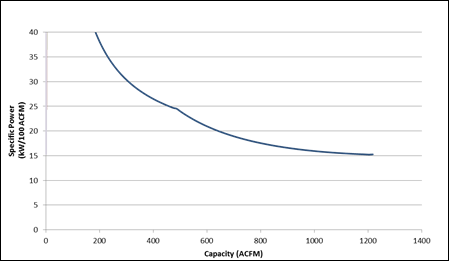
Answer
Using
the previous examples, a compressor with an effective trim capacity of at least
400 acfm is necessary.
Looking
at the graph, the minimum specific power (labeled as A below) occurs at full
load - a capacity of 1218 acfm, with a specific power of 15.3 kW/100acfm.
Using this minimum specific power, the upper bound is 15.3 * 1.15 = 17.56
kW/100acfm or 15% higher than the minimum specific power. This puts the
ends of the effective trim capacity at 1218 acfm (labeled as B) and 804 acfm
(labeled as C), resulting in an effective trim capacity of 1218 – 804 = 414
acfm. This is larger than the Largest Net Capacity Increment of 400 acfm
so this compressor would comply as a trim compressor for this
system.
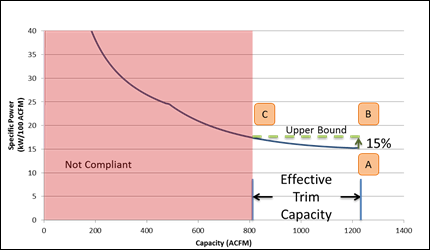
For compliance option 2, the system must include primary
storage that has a minimum capacity of 2 gallons for every acfm of capacity of
the largest trim compressor.
Example
10-64
Question
What
is the required minimum primary storage capacity for the trim compressor from
the previous example to comply with Option 2?
Answer
This
compressor has a rated capacity of 1218 acfm, and per §120.6(e)1B it must have 2
gallons of storage per acfm of rated capacity or 1218 * 2 = 2,236 gallons of
storage.
G.
Controls (§120.6(e)2)
This requirement applies to new and existing facilities that
are being altered with ≥100 hp of installed compressor capacity. The
section requires an automated control system which will optimally stage the
compressors to minimize energy for the given load. With new systems, this
ideally means that at any given load, the only compressors running at part-load
are the trim compressors. Because not all systems are required to upgrade
the trim compressor, the installed controls must stage the compressors in the
most efficient manner.
This requirement also mandates the measurement of air
demand. The control system must be able to measure or calculate the
current system demand (in terms of actual cubic feet per minute of
airflow). There are a variety of ways to accomplish this, including but
not limited to the following sensors:
•
A flow meter
•
Pressure transducers, or
A combination of pressure transducers and power meters
H.
Acceptance (§120.6(e)3)
New systems and altered systems must be tested per NA7.13.
10.8.3
Prescriptive Measures §140.9
There are no prescriptive measures for compressed air
systems.
10.8.4
Additions and Alterations
These requirements apply to existing systems which are being
altered and which have a total compressor capacity of ≥25 hp. These
requirements will be triggered by replacing a compressor, adding a compressor,
or removing a compressor.
10.8.5
Compliance Documentation
NRCC-PRC-10-E for Compressed Air Systems
Requirements
Page 1 of 3
Page 1 of 3 includes system capacity and controls
Details.
Project Description
PROJECT NAME is the title of the project, as shown on the
plans and known to the enforcement agency.
DATE PREPARED is the last revision date of the plans.
If the plans are revised after this date, it may be necessary to re-submit the
compliance documentation to reflect the altered design. Note that it is
the enforcement agency’s discretion whether or not to require new compliance
documentation.
General Information
PHASE OF CONSTRUCTION indicates the status of the building project
described in the compliance documents. Refer to Section 1.7 for detailed discussion of the
various choices.
NEW CONSTRUCTION should be checked for all new buildings, newly
conditioned space or for new construction in existing buildings (tenant
improvements, see Section
1.7.11 and 1.7.12)
that are submitted for envelope compliance.
ADDITION should be checked for an addition which is not treated
as a stand-alone building, but which uses option 2 described in Section
1.7.14. Tenant improvements that increase conditioned floor area
and volume are additions.
ALTERATION should be checked for alterations to an existing
building mechanical systems (see Section
1.7.13). Tenant improvements are usually alterations.
Mandatory Measures Note Block
List the total horsepower of the compressed air system
capacity for the current system (if applicable) and the proposed system in the
provided spaces. The person with overall responsibility must ensure that the
proposed system meet the requirements of 120.6 of the
standards by completing this section.
Documentation Author’s Declaration Statement
The CERTIFICATE of COMPLIANCE – Compressed Air Systems
Requirements is signed by both the Documentation Author and
the Principal Designer who is responsible for preparation of the plans of
building. This latter person is also responsible for this compliance
documentation, even if the actual work is delegated to a different person acting
as Documentation Author. It is necessary that the compliance documentation
be consistent with the plans.
DOCUMENTATION AUTHOR is the person who prepared the
compliance forms and who signs the Declaration Statement. The person’s
telephone number is given to facilitate response to any questions that
arise. A Documentation Author may have additional certifications such as
an Energy Analyst or a Certified Energy Plans Examiner certification
number. Enter number in the EA# or CEPE# box.
Principal Designer’s Declaration Statement
The Declaration Statement is signed by the person responsible
for preparation of the plans for the building. This principal designer is
also responsible for this compliance form, even if the actual work is delegated
to someone else (the Documentation Author as described above). It is
necessary that the compliance documentation be consistent with the plans.
The Business and Professions Code governs who is qualified to prepare plans and
therefore to sign
this statement. See Section
2.2.2 Permit Application for applicable text from the Business and
Professions Code.
Page 2 of 3
Page 2 of 3 includes mandatory requirements for Trim
compressor and storage requirements. As stated on the page, the
required information should be either 'listed on the form or the page from the
plans or specifications section and the paragraph displaying the required
information should be indicated on the form.
Page 3 of 3
Page 3 of 3 includes Acceptance Testing and
declaration statement. Please refer to the Nonresidential Appendices,
NA 7.13 for relevant
tests.








